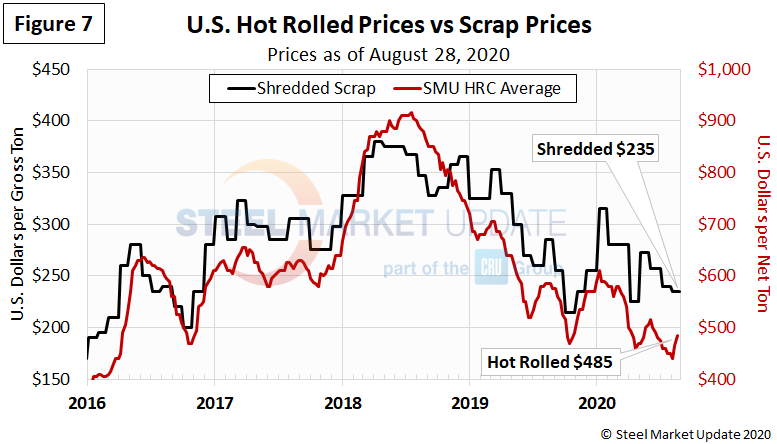Prices

August 31, 2020
Raw Materials Prices: Iron Ore, Coking Coal, Pig Iron, Scrap, Zinc
Written by Brett Linton
Among steelmaking raw materials, the prices of iron ore, pig iron and zinc have seen big gains in the past three months. Scrap prices have been challenged, but saw some improvement in August, notably in the coastal regions, and are expected to rise in September, lending support to higher finished steel prices.
Table 1 summarizes the price changes through Aug. 28 of the five materials considered in this analysis. It reports the month/month, three months/three months and year/year changes on a percentage basis.

Iron Ore
The Chinese import price of 62% Fe content iron ore fines bounced between $82-$97 per dry metric ton in the first quarter of 2020, ramping up beginning in May and soaring past the previous year’s high in mid-August. Figure 1 shows the price of 62% Fe delivered North China since January 2018, currently at $126.3 and up 48.6 percent over levels one year ago.

Coking Coal
The price of premium low volatile coking coal FOB east coast of Australia continued it’s decline since late-March, currently at $104.3 dollars per dry metric ton as of Aug. 26 (Figure 2). The seaborne coking coal price has not been able to fully benefit from the strong demand in China due to import restrictions. Recent coking coal prices remain at their lowest levels seen in SMU’s limited history.

Pig Iron
Most of the pig iron imported to the U.S. currently comes from Russia, Ukraine and Brazil. This report summarizes prices out of Brazil and averages the FOB value from the north and south ports. The latest data through Aug. 26 shows an average pig iron price of $330 per metric ton, up from $313 in July and up from $295 in June. Pig iron prices had declined erratically since mid-2018, but have risen each month since June 2020 (Figure 3).

Scrap
Hot rolled steel prices fluctuate up and down with the price the mills must pay for their raw materials. Changes in the relationship between scrap and iron ore prices offer insights into the competitiveness of integrated mills, whose primary feedstock is iron ore, versus the minimills, whose primary feedstock is scrap. Prices for prime and obsolete scrap have seen declines for much of the year, but have gotten a boost from coronavirus recovery and strong export demand in recent weeks and are expected to rise in September. Figure 4 shows the spread between shredded and busheling, both priced in dollars per gross ton in the Great Lakes region.

Figure 5 shows the recent spread between the price of iron ore, at $126.3 per dry metric ton, and shredded scrap at $235 per gross ton. Ore has soared higher since May, lending some support to finished steel prices.

To compare the two, Steel Market Update divides the shredded scrap price by the iron ore price to calculate a ratio (Figure 6). A high ratio favors the integrated/BF producers, a lower ratio favors the minimill/EAF producers. As the 1.86 ratio shows, the increases in the price of ore, in contrast to the decreases in the price of scrap, have added to the minimills’ competitive cost advantage.

Figure 7 shows how the price of hot rolled steel generally tracks with the price of shredded scrap. The two prices have diverged since our last update in July. Shred fell by approximately $5 from July to August, while hot rolled prices rose $10-35 per ton over that same period.

Zinc
Zinc, used to make galvanized and other products, has steadily risen since mid-March, reaching a nine-month high last week (Figure 8). The LME cash price per pound of zinc as of Aug. 28 was $1.1331, up 38 percent from the mid-March low of $0.8236. The price of zinc factors into the coating extras charged by the mills for galvanized products. Many mills had revised their coating extras downward, effective in July, to reflect the lower zinc price. Now that zinc prices are on the rise, many mills are revising their coating extras higher. Aluminum prices, which factor into the price of Galvalume, have been slowly increasing over the last few months. Aluminum prices often have large swings and return to typical levels within a few days, as seen just last week. The LME cash price per pound of aluminum was $0.7971 as of Aug. 28.







